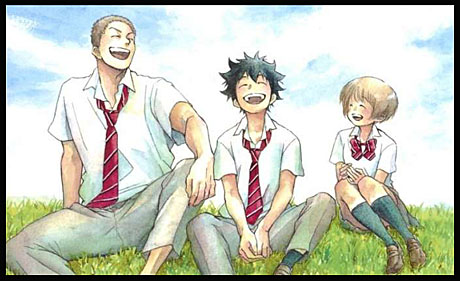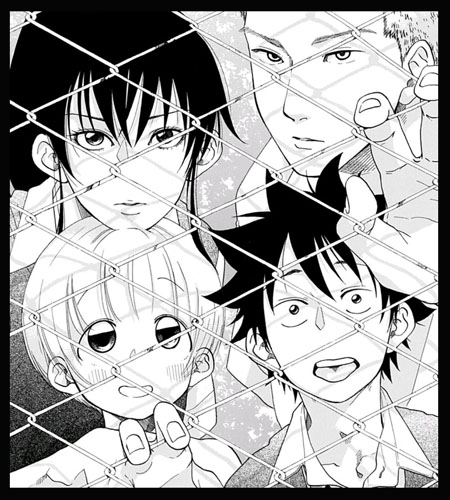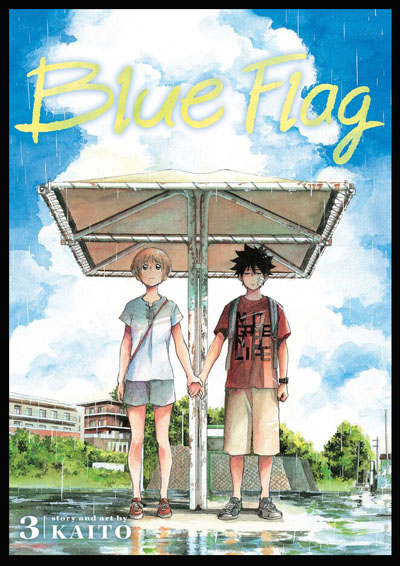
High school is a miserable time, when kids battle raging hormones, crushing insecurities and never-ending drama. In Kaito’s new manga Blue Flag (Ao no Flag), the students at Aohama High experience all the usual problems–plus some unusual ones.
Alienated senior Taichi Ichinose has never forgiven himself for failing to prevent a cat from getting run over by a car when he was in sixth grade. Convinced he’s an ineffectual nobody, he slouches through life, trying to avoid creating another reason to loath himself.

Sitting next to Taichi in class is Futaba Kuze, a shy, awkward girl he finds irritating for reasons he can’t define. Futaba nervously makes mistakes and constantly apologizes. Yet she asks Taichi for help her win his childhood friend Toma’s affection.
The star of the baseball team, Tom Mita is “talented and above average at everything he does. Add to that the fact that he’s 6’2”, conventionally attractive, well-built, friendly, popular and funny—it’s no surprise all the girls in the school are obsessed with him.” Although he occasionally mentions a hopeless love for an unnamed girl, Toma never dates any of his admirers: He’s in love with Taichi.
The only character shrewd enough to recognize Toma’s secret is Masumi Itachi, a smart, athletic girl who can make Akane in Ranma ½ seem mild-mannered. She befriends Toma, telling him “you and I are the same.” She nurtures a crush on Futaba, and sighs over her soft, fluffy hair.
Masumi is the most perceptive member of the cast. If anything, Futaba is even more clueless than Taichi: She can’t understand why Masumi accepts guys as boyfriends, then quickly breaks up with them. Toma thinks Futaba has a crush on Taichi and gives her a pep talk about him, savoring the chance to praise the guy he loves.
More LGBTQ characters are appearing in contemporary graphic novels and manga. But the depth and complexity of Kaito’s characters sets Blue Flag apart; so does its fine draftsmanship. Kaito’s designs are not particularly original: Taichi looks like a cross between a slightly older Deku in My Hero Academia and Yoshida in His Favorite. But Kaito’s drawings reflect a solid knowledge of anatomy and an impressive ability to render human expressions.

Futaba’s and Taichi’s bad posture suggest their discomfort around people—in contrast to Toma’s confident, athletic stance. Itachi’s face shows her straining to control her fury when she berates Taichi for setting up Futaba to be hurt in her hopeless pursuit of Toma. Conversely, Toma’s smile conveys his barely contained pleasure at watching Taichi.
Kaito skillfully maintains the suspense: At the end of Volume #3, the reader has no idea how the relationships will play out. When history starts to repeat itself, Taichi dives into the street to save a kitten from an oncoming car: He would have been killed if Toma hadn’t pushed him to safety.
Toma breaks his leg in the rescue, which his—and the Aohama student body’s–dream of playing in the annual Koshien Tournament, a major event in Japan. When Taichi tearfully apologizes, Toma angrily shouts, “This is your life we’re talking about! There’s nothing more important to me than YOU,” then realizes he’s said too much. But Taichi holds Toma’s hand while they watch the game he can’t play in.
Futaba takes Taichi’s hand when she comforts the miserable kid, who blames himself for everyone’s problems. Itachi makes Futaba realize it’s Taichi she’s fallen for, not Toma. Eventually Taichi will make someone happy…and someone very unhappy. But who?
Kaito has created an exceptional manga that deserves recognition at the Eisner Awards, the Angouleme Festival and other graphic novel awards.

Blue Flag, Volumes 1-3
Viz: $12.99 each; 224 pp.
- REVIEW: “Haikyu!! The Dumpster Battle” - July 2, 2024
- Charles Solomon’s Animation Year End Review 2023 - December 28, 2023
- INTERVIEW: Makoto Shinkai on “Suzume” - November 27, 2023


 August 19th, 2020
August 19th, 2020  Charles Solomon
Charles Solomon  Posted in
Posted in  Tags:
Tags: 






